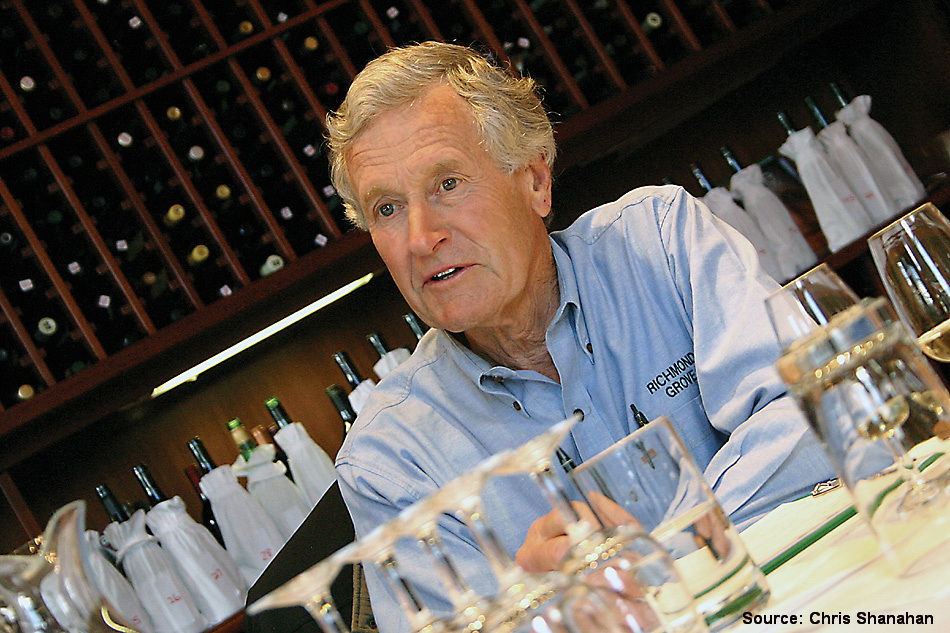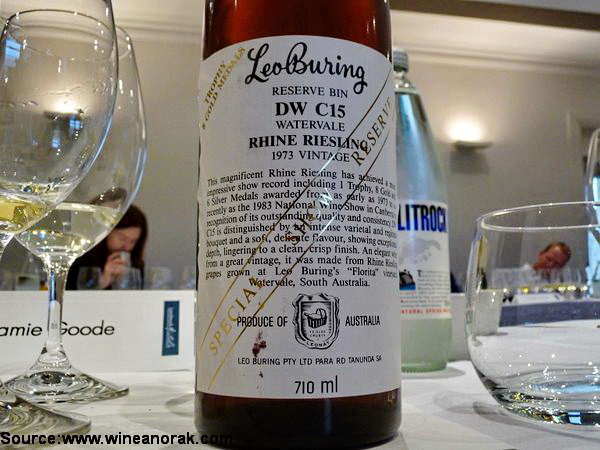If Max Schubert and John Vickery had been making wine in Germany, John would be the more famous of the two by far. Why? Because John made the best Rieslings down under for decades, and Riesling is the King of wine in Germany.
John’s career makes a fascinating story since it reflects the evolution of Australia’s table wine industry with its colourful characters and mad excesses. Leo Buring hired John Vickery straight out of Roseworthy College in 1955. In those days, most wine grapes in the Barossa, Eden and Clare valleys were produced by growers who sold them to the few wineries that existed then. Winemakers like John Vickery had access to the best material, and he earned his early stripes here.
Over the years, John’s attention to detail and obsession with cleanliness in the winery became the stuff of legend, and having to ship the newly made wines to Leo Buring’s bottling plant in Redfern in 4000 litre steel railway carriages must’ve given him nightmares. Despite these obstacles, he made Rieslings in the sixties and seventies under the Leo Buring label that served as benchmarks to other winemakers for decades.
John Vickery was a genius with Riesling, but few people know that he made the reds for Lindemans’ Coonawarra operations from 1974 to 1980. He won a Jimmy Watson Trophy for the 1980 St George.
Lindemans
Leo Buring also owned a vineyard called Florita, which was planted to the Sherry grapes Palomino and Pedro Ximinez. Sherry was the most popular wine down under in the 1950s and early sixties, and Leo Buring sold his under the Florita Fino label.
Leo died in 1961 aged 85, and Lindemans CEO Ray Kidd bought the company. Ray foresaw the market turning toward table wine early on, and had created Ben Ean Moselle in the late fifties when he was winemaker at Lindemans’ Corowa winery near Rutherglen.
Ray Kidd told me that Hamilton’s Ewell Moselle was the market leader of this new, slightly sweet, low alcohol wine style that was becoming ever more popular ‘with the ladies’. It was made from Pedro Ximinez and Verdelho, believe it or not; Ben Ean was a blend of Hunter Semillon and South Australian Riesling.
The Classics
In the early seventies, the farsighted Ray Kidd had begun laying down some of Lindemans’ best wines in the cellars of the company’s Nyrang St, Auburn (Sydney) headquarters. Lindemans Nyrang Hermitage and Auburn Burgundy paid an interesting tribute to the company’s location and vast cellars.
In the eighties, Lindemans began releasing some of these wines in regular tranches. There were two levels of releases: Classic and Fine Aged Premium. The Classics were expensive but included the great Hunter Semillons made by Karl Stockhausen, alongside the Reserve Rieslings made by John Vickery – all from that golden era which produced wines like none before or since. Here’s a later piece from Chris Shanahan on this topic, with more details.
The real bargains were found among the FAPs, though: I remember buying loads of a 1967 Hunter River Burgundy, a lovely soft red that had been eclipsed by its more muscly 1966 and 1965 siblings. To me, the 1967 was a classic Hunter Shiraz: soft, sweet and earthy, medium bodied and smooth, light on its feet yet perfectly balanced. We drank it over the next ten years, and every bottle was a delight.
The program was such a success that Ray Kidd wanted to expand the cellars at Auburn but the cost accountants at Philip Morris put an end to that idea. In 1986, they decided to move the cellars to Karadoc and just leave the offices at Auburn Street.
Wineries Rebirthed
In the early nineties, with Lindemans sold to Heinz and CEO Ray Kidd retired, John Vickery was making Riesling once again: this time for Richmond Grove. This shingle used to adorn a Hunter Valley winery that fell into the corporate meat grinder and ended up in the hands of Orlando Wyndham, who moved the cellar door to Chateau Leonay in the Barossa.
This must’ve been a strange déjà vu for John Vickery who made wines for Leo Buring here decades ago. He just got on with the job as usual, and made more splendid Rieslings there until he retired in 2009. Vickery was one of the early champions of the Stelvin cap, and his classic steel capped Rieslings helped other winemakers see the light.
Wine Makers Revitalised
In 2014 John Vickery was once again making Riesling, under yet another label: his own. He was 82, the same age another Barossa Great was when he died the year before – Peter Lehmann. As it happens, Peter’s youngest son Phil is helping John with the making of these new Rieslings. Phil is the chief winemaker at WD Wines, which is owned by the Hesketh family in Adelaide.
It was Robert Hesketh who financed Peter Lehmann decades ago after Saltram fell into the hands of Dalgetty. The new owners told Peter to cut Saltram’s growers loose, but he told Dalgetty to jump and started Masterson Wines which later became Peter Lehmann Wines. He took the name from a mad gambler in a Damon Runyon story. More on that below.
I guess Robert lured John Vickery out of retirement in 2014 by offering to give him his own label. Just as he did in the old days, John made Rieslings from The Clare and Eden Valleys – one brand, two labels, recently joined by ‘reserve’ labels. He and Phil Lehmann made some great wines together, until Phil left in 2018 to focus on his own label ‘Max & Me’, and his new winemaking contracts with Mountadam and Eden Hall.
Andrew Hardy took over as chief winemaker at WD Wines, and Keeda Zilm now makes the Vickery Rieslings, with John looking over her shoulder. John is 88 now, and still going strong. He won some 50 trophies and 400 gold medals for his employers in over 50 years of winemaking. What a life, and what a legacy.
Photo credit: John Krüger
Footnote
The Masterson label came about because Peter Lehmann was a great fan of Damon Runyon’s Guys and Dolls stories from the 1920s and 30s. They featured gangsters, gamblers and other characters of the New York underworld, and Sky Masterson was one of these: a gambler willing to bet on anything.
The final twist in this stoy is that my Dad was a mad keen fan of Damon Runyon’s stories. I loved them too, despite reading them in their German translation (I grew up in Germany). It boggles the mind how a writer can capture New York slang in a German translation but this one had succeeded. I’d love to find a copy of the book somewhere.
Additional Reading
The Rise and fall of Ben Ean Moselle, via The Conversation
Lindemans – Death By a Thousand Cuts. What’s left? Low Calorie Confections and Fairy Floss
John Vickery – Riesling Meister, People of Wine. Really comprehensive insights and images by photographer Milton Worldley
Florita — the story of a vineyard, by Chris Shanahan



